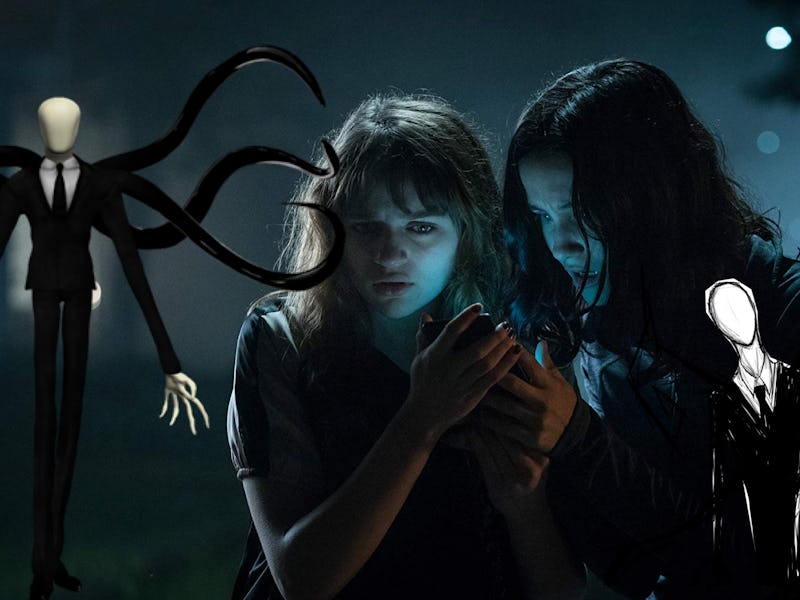The 'Slender Man' Movie: How Internet Legend Became a Technophobic Horror
Forget whether it's good. "Slender Man" isn't even scary.

Both Joey King and creepypasta are having a moment. So when the 19-year-old, fresh off the success of Netflix’s The Kissing Booth, appeared in the first trailers for Sony Pictures’ Slender Man, the pair seemed destined for frighteningly good fireworks. Unfortunately, The Slender Man has a poor IRL history… this movie is no exception.
For those who aren’t aware of his origins, The Slender Man might seem like just another horror movie monster. His suit and tie, along with his long limbs and twisted fingers, recall The Babadook’s titular character. The way he looms out of nowhere with an impossibly tall, and, er, slender frame, are just like the entity in It Follows. And that face, or lack thereof, is reminiscent of the stitch-mouthed villain of Sinister. But unlike those figures, The Slender Man isn’t an original Hollywood concept. He’s a Photoshopped creation meant to inspire a different kind of a fear, one unique to internet forums and late-night conversations with anonymous strangers.
Sometimes creepypasta is profoundly written and terrifying. Even though the countless fables and tall tales revolving around Eric Knudson’s mysterious creation, The Slender Man, aren’t always cognizant, let alone well-crafted, a well-wrought piece of filmmaking can be delivered starring an internet legend. “The Smiling Man” short film and the “Marble Hornets” faux documentary series are wonderful examples. But the men who wrote and directed Slender Man created an absolute monstrosity with their rendering of a beloved online horror icon — and they had the funding of a major motion picture studio to do it with, too. What gives?
This is director Sylvain White’s first wide release. It’s clearly inspired by The Slender Man’s online predecessors. The movie’s premise is that the four girls find a video that transmits Slender Man’s curse via online summoning and subsequently “infect their brains” with his presence during a sleepover. It’s all fun and games until Slendy shows up IRL to kidnap, hypnotize, and harass the group one by one.
"Slender Man" relies on a lot of pointless body horror to increase shock value.
The script is surprisingly in tune with the way today’s high schoolers speak and interact online, with a few major exceptions. The characters’ parents, as in any mediocre horror movie, have absolutely no role in their children’s lives, and the plot transcends the reality of modern technological capabilities a few too many too many times — FaceTime has literally never looked better. Where White really goes wrong is when he weaponizes all the fun and subsequent fear of creepypasta culture and turns it into a joyless jump scare. The overall problem with Slender Man isn’t just that it fails to be frightening and leaks confusion from endless plot holes, though.
From the get-go, Slender Man contextualizes itself in its own problematic history. Slender Man’s troop of teen girls live in the fictional, American suburb of Winsford, which is similar to the actual Waukesha, Wisconsin, where two 12-year-old girls attempted to stab their friend to death in 2014 as an offering to The Slender Man. Theaters around Milwaukee won’t be showing Slender Man this weekend out of respect for the victims. The case is well-documented across a variety of essays, think pieces, and features. Some argue Slender Man is capitalizing on real-life bloodshed. But even bigger problems exist with the movie’s narrative.
There’s a reason creepypasta has yet to break into mainstream entertainment — its fear isn’t reliant on special effects. It’s hard to replicate the fear of a forum. But it’s been done before, like in the meme-able video game iteration Slender: The Eight Pages. The game works because it maintains what made Slendy so creepy, which was the mystery behind his madness. What does he do when he catches you? What is he? What does he want? We don’t know, and we just have to guess. What we imagine the answers could be are far scarier than what Sony Pictures can think up.
What’s worse than a misunderstanding of why The Slender Man is scary, though, is a misunderstanding of The Slender Man’s roots. The takeaway from Slender Man is that the internet itself is the monster. The film carries a warning — if you read about him, watch videos of him, and share his stories with your friends, that’s how he’s going to get you. As long as you put your phone down, you’ll be safe.
As someone who was once a teen girl obsessed with short, online scary stories, I can attest that The Slender Man and every other internet cryptid easily slip under your skin. You’re knee-deep into page after page of poorly written snuff fic, and suddenly you can’t sleep at night. You share the stories via text and Tumblr. It’s a modern-day campfire tall tale that lives in your cell phone and manifests its way into your deepest fears and teenage insecurities. In one way, the film is right. The only way creepypasta can get you is if you read it. But that’s not a problem. That’s the fun of it.